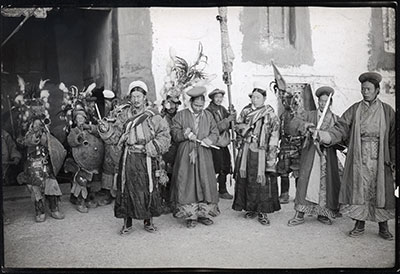
1998.131.604.3 (Print black & white)


1998.131.604.3 (Print black & white)

Frederick Spencer Chapman
Frederick Spencer Chapman
February 10th 1937
Lhasa > Potala > Eastern Entrance
1998.131.604.3
129 x 189
Print gelatin silver
Donated 1994
Mrs Faith Spencer Chapman
British Diplomatic Mission to Lhasa 1936-37
Frederick Spencer Chapman
C.20 [view film roll]
SC.T.2.604
'Lhasa Mission 1936, Diary of Events', P. Neame, H. Richardson, F. S. Chapman, Government of India Political Department [Note: photographs for October 18th - November 4th 1936 are not included as their relationship to text is not detailed; see Mission Diary text for details of images] [view list of illustrations]
Notes on print/mount - The back of the print is covered in crop marks and reproduction instructions. The reference 'C.20' has been written on the back of this print in pencil [MS 04/04/2006]
Manual Catalogues - Caption in Chapman's hand-written list of negatives made whilst on the Mission to Lhasa, 1936-7 [See PRM Manuscripts Collection]: '1/2 Close of war dance soldiers’; PRM Manuscripts Collection: ‘List of Tibetan Prints and Negatives’ - Book 3: ‘3/1 - New Year celebrations at the Potala Feb 1937. Minor officials in ceremonial dress and boys dressed in ancient armour’ [MS 04/04/2006]
Other Information - Description: Entry in Mission Diary for February 10th 1936: "Today we were invited by the Tibetan Government to witness the first of the ceremonies connected with the Tibetan New Year. // With sound reasoning the Tibetans hold that before you can hope to celebrate and [ sic ] auspicious New Year, all the evil influences which have accumulated during the Old Year must be driven out. Accordingly on the 29th day of the last month a devil dance takes place in the great Eastern Court of the Potala. // All officials from the Regent down are present, those of the higher ranks in the rooms in the high Western facade above the triple steps which lead down into the court. // The red, black, and yellow pelmets over the windows flap and belly in the chilly north wind. Three blasts of the great silver trumpets herald the approach of the Lama band who take up their places with their drums, cymbals and trumpets in a gaily embroidered tent which occupies all the Northern side of the court" ['Lhasa Mission, 1936: Diary of Events', Part XIV pp. 1-2, written by Richardson] [MS 04/04/2006]
Other Information - Cultural Background: The “Tse Gutor” masked dance ceremony takes place at the end of the Tibetan calendar and is designed to purge the sins of the past year. At the Potala it is performed by the monks of Namgye Tratsang who undergo training for many years. Richardson gives a detailed account of this event in “Ceremonies of the Lhasa Year”: “The chief is the Chinese priest Hashang, a huge heavily padded figure in a scarlet robe and with a massive, smiling bald-headed mask. With him are two tiny child-like figures, two more in the dress of Indian sadhus, and two with death’s head masks” (1993:116 – 123) Then two more masked dancers arrive - one representing Shinje the lord of the dead and protector of the Buddhist faith and the other, the stag-headed Tsamuntri. Other dancers portray wrathful protector deities such as Dorje Jigje (with a bull’s head), Tamdrin (the horse-headed), a red masked Mahakala and the black-faced Lhamo. [CH 2003]
Other Information - Related Images: Images prefixed with 'C' comprise a group of negatives containing images of the Potala and dancers at the Potala. They seem to have been taken on or around February 10th 1937, mainly related to the Tse Gutor ceremony on that day [MS 02/04/2006]
Other Information - Location: This image was probably taken at the end of the dances before the participants descend the Potala steps to watch the final procession around the base of the hill as they seem to be standing in front of the entrance to the Deyang Shar or Eastern Courtyard [MS 06/04/2006]
For Citation use:
The Tibet Album.
"Zimchongpa and officials ready for Tse Gutor"
05 Dec. 2006. The Pitt Rivers Museum.
<http://tibet.prm.ox.ac.uk/photo_1998.131.604.3.html>.
For more information about photographic usage or to order prints, please visit the The Pitt Rivers Museum.
© The Pitt Rivers Museum